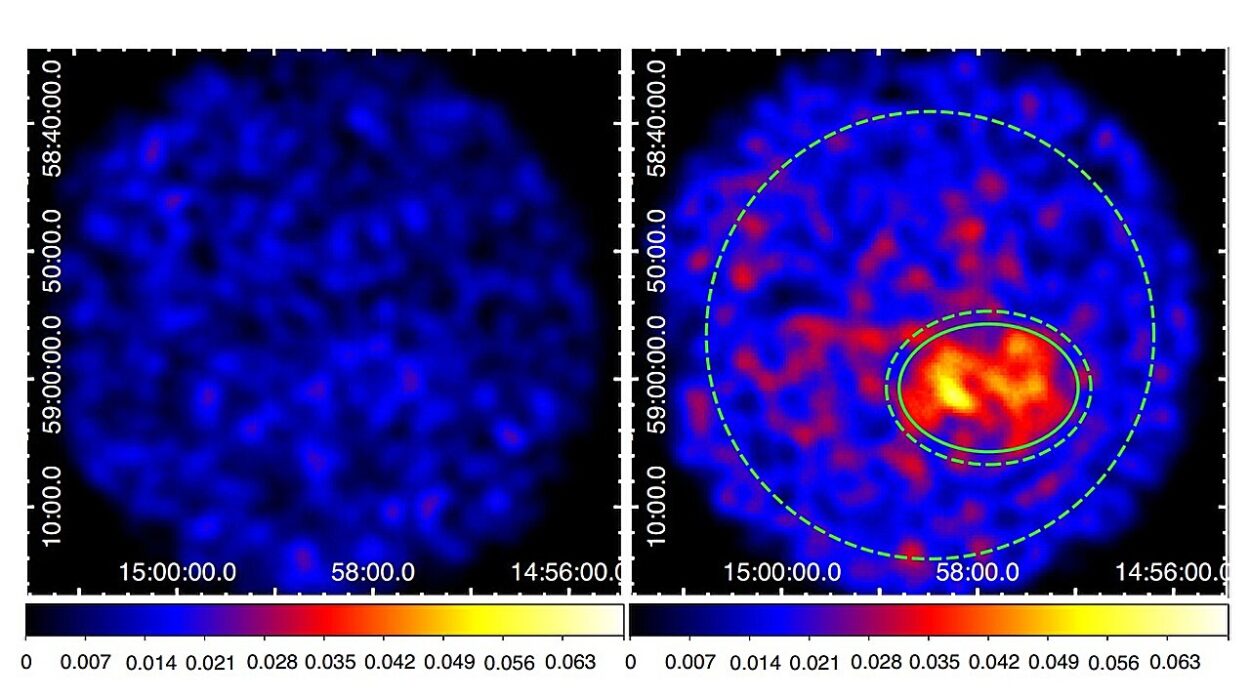Astronomers have long imagined the birthplaces of planets as serene nurseries of dust and gas gently swirling in protoplanetary disks. But recent observations from the James Webb Space Telescope (JWST) have peeled back the veil on one of the universe’s most extreme and exotic planetary systems. Meet WASP-121b—a behemoth of a planet, superheated and tidally locked, yet harboring chemical clues that point to an origin story far from its current hellish orbit.
What’s emerging from this research isn’t just a portrait of a strange alien world. It’s a chemical map of planetary birth and migration, one that reshapes how astronomers think about the life cycle of gas giants and the fiery transformations they undergo.
A Planet That Shouldn’t Exist Where It Is
WASP-121b defies easy categorization. Located roughly 900 light-years from Earth, it is classified as an ultra-hot Jupiter. This means it’s a gas giant, much like our own Jupiter, but roasting in close proximity to its host star—so close, in fact, that it whips around its sun in just 30.5 hours, skimming a distance only twice the star’s diameter.
On its dayside, WASP-121b reaches temperatures that can exceed 3,000°C, hot enough to vaporize metals and break molecular bonds. Its nightside, cloaked in perpetual darkness due to tidal locking, is cooler—but only comparatively—with temperatures around 1,500°C. For a gas giant, this kind of thermal dichotomy is a laboratory of extremes.
But what really captivated astronomers were the molecules found floating in this turbulent atmosphere: water vapor, carbon monoxide, silicon monoxide, and—most intriguingly—methane. Each of these chemical species becomes a clue in reconstructing the story of the planet’s violent evolution.
JWST’s Spectral Sleuthing Powers
To unravel WASP-121b’s mysteries, scientists turned to JWST’s Near-Infrared Spectrograph (NIRSpec), an instrument designed for peering into the atmospheres of distant worlds. By capturing the planet’s light during an entire orbital cycle, JWST gave researchers a complete view of its atmospheric composition—on both the blistering dayside and the smoldering nightside.
This wasn’t just about cataloging molecules. The way each compound absorbs and emits infrared light reveals its abundance, temperature, and even altitude in the planet’s atmosphere. During transit, as WASP-121b passed in front of its star, starlight filtering through its atmospheric limb encoded spectral “fingerprints”—unique identifiers for the gases it encountered.
The results were both exciting and puzzling. Water vapor and carbon monoxide appeared as expected. But methane, a molecule known to break apart in high heat, was not only present—it was plentiful. Even more baffling, it was only found on the nightside, while completely absent from the dayside and the limb between hemispheres. This discovery shook foundational assumptions about atmospheric mixing on such hot exoplanets.
Planetary DNA: A Forensic Inventory of the Atmosphere
At the heart of this research lies a fundamental scientific pursuit: figuring out where planets come from. By analyzing WASP-121b’s atmospheric inventory, astronomers could reverse-engineer its birth environment.
Methane is particularly telling. On Earth, it’s a greenhouse gas; on WASP-121b, it’s a chemical fossil. Its survival in the upper atmosphere, despite such intense temperatures, suggests that this gas was either constantly replenished or somehow shielded from destruction. And that means strong atmospheric dynamics—namely, vertical winds—must be at play.
Silicon, detected as silicon monoxide, also offers a crucial clue. Normally, silicon is bound in solid rock—locked inside minerals like quartz or silicates. Its presence in gaseous form indicates that the planet has a temperature high enough to vaporize rock. But that rock didn’t originate there. It had to come from planetesimals—the rocky building blocks of planets—that fell into the planet after its gas envelope had formed. This layering of materials is a smoking gun pointing to planetary migration.
The Great Migration: From Cold Cradle to Fiery Furnace
The key revelation from the JWST observations is that WASP-121b did not form where it currently orbits. Instead, it was likely born in the cooler, more distant regions of its star’s protoplanetary disk—somewhere between what would be Jupiter and Uranus’s orbit in our own solar system.
There, temperatures are cold enough for water to freeze, but warm enough for methane to stay gaseous. In that zone, icy pebbles and rocks coalesce, and carbon-rich gases swirl through the nebula. It was in this “sweet spot” that WASP-121b began pulling in its atmosphere.
As the planet grew, it drifted inward toward its star. During this journey, the frozen water (and oxygen-rich material) became increasingly scarce, while methane—a carbon-rich compound—was still available in gas form. This explains why WASP-121b’s carbon-to-oxygen ratio is unusually high. It captured more carbon than oxygen as it migrated, leaving a chemical fingerprint of its path imprinted in its skies.
Atmospheric Ballet: Vertical Winds and Chemical Surprises
In theory, a hot planet like WASP-121b shouldn’t have methane in its upper atmosphere at all. On the dayside, the gas is destroyed by heat. And on the nightside, atmospheric models suggest that air from the dayside—lacking methane—should sweep across the planet quickly enough to suppress any methane formation.
But JWST showed something else entirely. Methane is abundant on the nightside, implying that cooler gas rich in methane is somehow being pulled upward from deeper atmospheric layers. This vertical mixing—something largely overlooked in existing exoplanet models—must be surprisingly strong.
“This is a major challenge to our understanding of atmospheric dynamics,” said Thomas Evans-Soma, the study’s lead author. “It means we need to think more seriously about how vertical winds operate on these exotic worlds.”
These vertical currents act like an atmospheric elevator, drawing methane from low-lying reservoirs into the observable upper atmosphere before it can be diluted or destroyed. Such dynamics may be common among other hot Jupiters, but until now, they’ve been invisible.
Planetary Time Machines
By decoding the elements in WASP-121b’s atmosphere, astronomers are essentially building a timeline of planetary formation. Each molecule represents a milestone: methane for early carbon-rich accretion; silicon monoxide for late-stage rocky impacts; and water vapor for the remnants of the icy outer disk.
In a broader sense, the study redefines what a planet’s atmosphere can tell us. It’s no longer just a weather report. It’s forensic evidence—a record of chemical processes, formation environments, and migratory journeys.
JWST’s unprecedented sensitivity and spectral range have opened this new window onto planetary evolution. It can peer through the glare of a star and extract the molecular whispers of a distant world’s past. WASP-121b is just the beginning.
Why WASP-121b Matters to Us
You might wonder: Why should we care about a planet so different from Earth that it vaporizes rock and rains metal? The answer lies in context. Every exoplanet we study adds a piece to the cosmic puzzle of how planetary systems evolve. Understanding WASP-121b helps astronomers determine what kinds of worlds are possible, and by extension, how rare or common Earth-like planets may be.
Moreover, the unexpected detection of methane in such hostile conditions forces scientists to re-evaluate climate and chemistry models—not just for WASP-121b, but for hundreds of exoplanets now under observation. These new insights could even inform our understanding of gas giants in our own solar system, like Jupiter and Saturn, whose formation histories are still not fully understood.
The Future: Planetary Atmospheres as Portals to the Past
WASP-121b’s dramatic story is a testament to what is now possible in the era of next-generation telescopes. With each new target, JWST is turning gas giants like this one into cosmic case studies—vivid illustrations of how planetary systems can grow, move, and transform under the influence of physics, chemistry, and time.
More missions will follow. With the European Space Agency’s ARIEL telescope set to launch in the late 2020s, dedicated to surveying the atmospheres of hundreds of exoplanets, we may soon move from individual narratives like WASP-121b to a statistical understanding of planetary evolution.
But for now, WASP-121b stands as one of the best-characterized hot Jupiters we’ve ever found. It’s a seething, stormy, chemical anomaly—and also a window into the deep past of a planetary system. Thanks to JWST and the astronomers interpreting its signals, this world’s story is no longer lost in the light of its star. It’s written in the language of molecules, decoded one spectral line at a time.
References: Thomas M. Evans-Soma et al, SiO and a super-stellar C/O ratio in the atmosphere of the giant exoplanet WASP-121 b, Nature Astronomy (2025). DOI: 10.1038/s41550-025-02513-x
Cyril Gapp et al, WASP-121 b’s Transmission Spectrum Observed with JWST/NIRSpec G395H Reveals Thermal Dissociation and SiO in the Atmosphere, The Astronomical Journal (2025). DOI: 10.3847/1538-3881/ad9c6e






